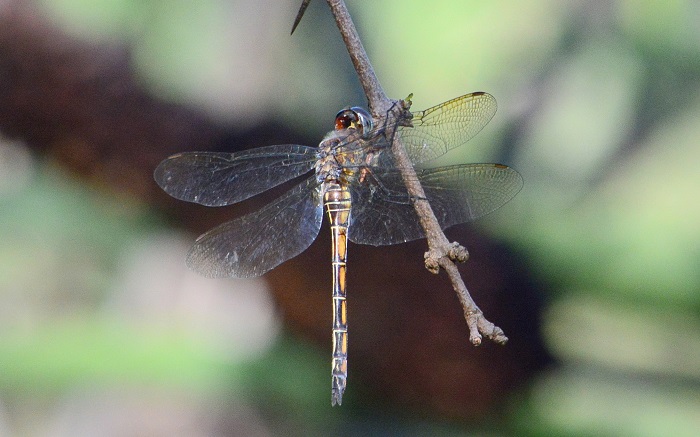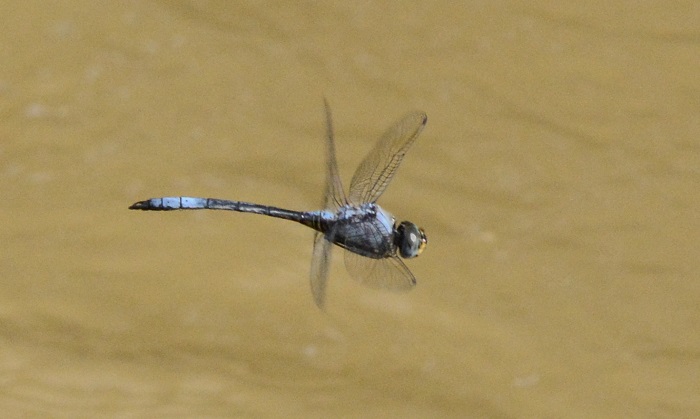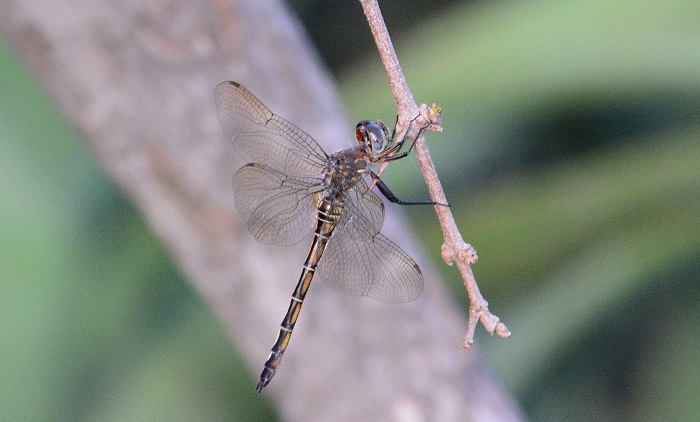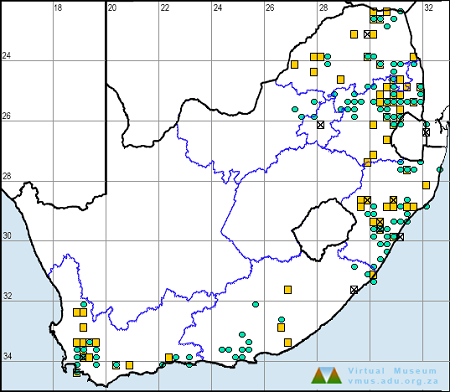Cover photo by Jean Hirons.
Find the Blue Cascader in the FBIS database (Freshwater Biodiversity Information System) here.
Family Libellulidae
Identification

Mkuze River, KwaZulu-Natal
Photo by Ryan Tippett
Large size
Length up to 54mm; Wingspan reaches 86mm.
The Blue Cascader is most likely to be mistaken for one of the blue skimmers (Orthetrum spp.), which it resembles in general size, shape, and colour. Zygonyx natalensis can be easily differentiated by the distinct gap in pruinosity along its abdomen and by its metallic blue frons. In addition, the Blue Cascader demonstrates very different behaviour to all of the skimmers.
Females most resemble both sexes of Zygonyx torridus (Ringed Cascader). They differ mostly in the size and shape of the yellow markings along the abdomen. Female Blue Cascaders show smaller, thinner yellow markings.
Click here for more details on identification.

Shayamoya Game Lodge, KwaZulu-Natal
Photo by Ryan Tippett
Habitat
The Blue Cascader inhabits rocky, fast-flowing streams and rivers. It is particularly fond of river stretches with ‘white water’ where there are rapids, cascades, and waterfalls. Females can sometimes be found some distance away from water in a variety of vegetation types. The Blue Cascader occupies rivers in the savanna, grassland, and fynbos regions.

Photo by Sharon Stanton
Behaviour
Blue Cascader males are frequently seen patrolling a stretch of water or hovering low down over rapids and waterfalls. They regularly return to hover at a favourite site after inspecting a length of river. The Blue Cascader can sometimes be found away from water, hunting over surrounding habitats. The flight is swift and powerful. The Blue Cascader hunts on the wing and is not often seen perched. Females are seldom seen and spend most of their time away from water.

Mkuze River, KwaZulu-Natal
Photo by Ryan Tippett
Status and Conservation
The Blue Cascader is locally common in South Africa. It is listed as of Least Concern in the IUCN Red List of Threatened Species. This species makes little use of man-made habitats other than artificial weirs that may simulate natural rapids and waterfalls. The Blue Cascader is reliant on healthy, flowing river systems.
Distribution
The Blue Cascader can be found over much of Sub-Saharan Africa, but is mostly recorded from Eastern and Southern Africa, ranging from Ethiopia to the Western Cape in South Africa.
Zygonyx natalensis is widespread in the northern and eastern parts of South Africa, where it is most numerous. Its range continues south to the Eastern and Western Cape, where it is more localised.

Shayamoya Game Lodge, KwaZulu-Natal
Photo by Ryan Tippett
Below is a map showing the distribution of records for Blue Cascader in the OdonataMAP database as at February 2020.

Below is a map showing the distribution of records for Blue Cascader in the OdonataMAP database as of December 2024.

The next map below is an imputed map, produced by an interpolation algorithm, which attempts to generate a full distribution map from the partial information in the map above. This map will be improved by the submission of records to the OdonataMAP section of the Virtual Museum.


Ultimately we will produce a series of maps for all the odonata species in the region. The current algorithm is a new algorithm. The objective is mainly to produce “smoothed” maps that could go into a field guide for odonata. This basic version of the algorithm (as mapped above) does not make use of “explanatory variables” (e.g. altitude, terrain roughness, presence of freshwater — we will be producing maps that take these variables into account soon). Currently, it only makes use of the OdonataMAP records for the species being mapped, as well as all the other records of all other species. The basic maps are “optimistic” and will generally show ranges to be larger than what they probably are.
These maps use the data in the OdonataMAP section of the Virtual Museum, and also the database assembled by the previous JRS funded project, which was led by Professor Michael Samways and Dr KD Dijkstra.

Mkuze River, KwaZulu-Natal
Photo by Marita Beneke
Further Resources
The use of photographs by Jean Hirons and Marita Beneke is acknowledged. All other photographs by Ryan Tippett.
Blue Cascader Zygonyx natalensis (Martin, 1900)
Other common names: Blouklatertjie (Afrikaans)
Recommended citation format: Loftie-Eaton M; Navarro R; Tippett RM; Underhill L. 2025. Blue Cascader Zygonyx natalensis. Biodiversity and Development Institute. Available online at https://thebdi.org/2020/02/20/blue-cascader-zygonyx-natalensis/
References: Tarboton, M; Tarboton, W. (2019). A Guide to the Dragonflies & Damselflies of South Africa. Struik Nature.
Samways, MJ. (2008). Dragonflies and Damselflies of South Africa. Pensoft
Samways, MJ. (2016). Manual of Freshwater Assessment for South Africa: Dragonfly Biotic Index. Suricata 2. South African National Biodiversity Institute, Pretoria
Martens, A; Suhling, F. (2007). Dragonflies and Damselflies of Namibia. Gamsberg Macmillan.

